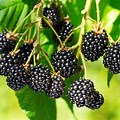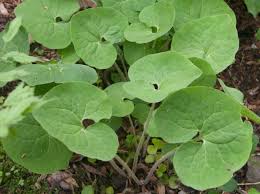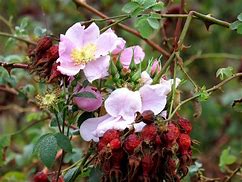Healing Herbs
Medicinal herbs are a part of any indigenous tribes' culture.
These gifts from the Earth Mother are revered, treated with great respect,
and information about them passed down through the generations. Many were
used for healing, many for spiritual use, many for dyes and tools and such.
These plants were as much a part of life as breathing. Fortunately, as the
shame of being a Native American seems to be slowly dissipating from our
current society (and let's all do our parts to encourage that trend to
continue!), many tribes are encouraging their youth to learn these ancient
arts, before all is completely lost to their cultures.
Let us look at a few herbs that are pretty common throughout North America.

(Wild Yam, Dioscorea villosa)
is a plant that was commonly used throughout its
is a plant that was commonly used throughout its
range in North America and Central America, being favored by all the tribes
in those regions for pain relief, most especially menstrual cramp relief. It
was also used to balance the hormones, bringing the libido back into balance,
as well as for easing the pain of childbirth. The root was most commonly used.
The tubers were also used for food, and many similar applications are
attributed to other Dioscorea species, such as those native to Hawaii.
Today, we use Wild Yam to do these very same things.

(Passionflower, Passiflora incarnata)
is a plant we commonly use today for
is a plant we commonly use today for
relaxing the muscles, easing tension, hyperactivity, insomnia, and as eyewash.
Native American tribes, most notably the Cherokee, used it as a poultice for
bruises and injuries, as well as for an overall tonic, as well as for the same
uses as today. The crushed fruits were used to make foods and beverages, the
roots as a blood tonic as well as for earaches and boils.

(Sage, Salvia spp)
had numerous uses through many tribes. It was used by
had numerous uses through many tribes. It was used by
numerous tribes for the medicinal uses of treating colds, bruises,
tuberculosis, upset stomach, childbirth and menstrual regulation, cuts,
perspiration, deodorant, and as an insect repellant. Curiously, we make
use of this plant for the same uses today. Spiritually, sage is a part
of the sweat lodge ceremony, many funerary rites, the Sun dance, and many
other religious ceremonies.



(Purple Coneflower, Echinacea purpurea, and its close relative Prairie
Coneflower, Echinacea angustifolia)
have for us today many legendary
have for us today many legendary
anti-bacterial and anti-viral applications, as well as for boosting the
immune system. Native tribes used these plants for treating toothache,
sore throats, burns, insect bites and stings, swollen glands, sores and
wounds, snakebites, headaches, bowel pain, rheumatism, and gonorrhea.
(Juniper)
is today a popular remedy for clearing excess uric
is today a popular remedy for clearing excess uric
acid from the body, urinary infections, gum disease, and dandruff. Native
American people used a decoction of the boiled leaves as a poultice for
joints affected by arthritis and rheumatism. It was also used to treat
consumption, for indigestion, to soothe the mother after childbirth, coughs,
gonorrhea, high blood pressure, and diarrhea. Flutes made from the branches
were used to "woo" a loved one, and the branches, leaves, and berries are
used ceremonially for everything from face paint to cleansing incense for
rituals. It was also used to make a green dye from the needles, and a red
dye from the berries.

(Willow, Salix)
has been used for centuries by us for treating pain,
has been used for centuries by us for treating pain,
including headache, toothache, and fevers. Interestingly, Native tribes
have been using the various willow species for much the same uses.
Depending on the species in their geographical areas, willows were used
for fevers, headaches, stomach problems, bleeding wounds, diarrhea,
mouth sores, eyewashes, and as an antiseptic. The willow had a large
role in tribal life, providing the materials necessary for baskets, homes,
drums, and many other necessary items. It was used in the Sun Dance
ceremony. Willow was also used to render a black dye.

(Dandelion, Taraxum officinale)
is used today for liver cleansing, blood
is used today for liver cleansing, blood
cleansing, circulation, and warts. Again, Native people used this
versatile plant for the same things. It was considered an important spring
tonic, and was used to treat warts, indigestion, sore throat, to purify
and cleanse the blood, increase lactation, liver spots, kidney pain,
menstrual cramps, and bruises. It was an important food herb as well.
The blossoms were used for a yellow dye.
(Caution !!!)
It must be remembered that these plants are very valuable as medicines because of the great chemical powers they contain. At the same time, these chemicals can be potentially dangerous if used in the wrong way. Cherokee herbalists have great experience, and have gone through extensive training and observation. Novice herbal practitioners are advised to seek out and develop a close relationship with Cherokee herbalists or their elders to learn how to use these medicines properly.

It must be remembered that these plants are very valuable as medicines because of the great chemical powers they contain. At the same time, these chemicals can be potentially dangerous if used in the wrong way. Cherokee herbalists have great experience, and have gone through extensive training and observation. Novice herbal practitioners are advised to seek out and develop a close relationship with Cherokee herbalists or their elders to learn how to use these medicines properly.
(Blackberry)
One of the herbs known the longest time for soothing stomach problems is the blackberry. Using a strong tea from the roots is helpful is reducing and soothing swollen tissues and joints. An infusion from the leaves is also used as a tonic for stimulating the entire system. A decoction from the roots, sweetened with sugar or honey, makes a syrup used for an expectorant. It is also healing for sore throats and gums. The leaves can also be chewed fresh to soothe bleeding gums. The Cherokee historically use the tea for curing diarrhea.

(Gum (Black Gum)
Cherokee healers use a mild tea made from small pieces of the bark and twigs to relieve chest pains.
(Hummingbird Blossoms) (Buck Brush)
This herb is used by Cherokee healers by making a weak decoction of the roots for a diuretic that stimulates kidney function.
(Cattail)
This plant is not a healing agent, but is used for preventative medicine. It
is an easily digestible food helpful for recovering from illness, as it is
bland. Most all parts of the plant, except for the mature leaves and the
seed head, are edible. Due to wide-spread growing areas, it is a reliable
food source all across America. The root has a very high starch content, and
can be gathered at any time. Preparation is very similar to potatoes, and
can be mashed, boiled, or even mixed with other foods. The male plant
provides a pollen that is a wonderful source for protein. You can add it as
a supplement to other kinds of flour when making breads.
Pull Out a Sticker (Greenbrier)
A decoction of the small roots of this plant is useful as a blood purifier. It is also a mild diuretic. Some healers make a salve from the leaves and bark, mixed with hog lard, and apply to minor sores, scalds and burns. Some Cherokee healers also use the root tea for arthritis.
(Mint)
Mint teas are a stimulant for the stomach, as it aids in digestion. The crushed and bruised leaves can be used as a cold compress, made into a salve, or added to the bath water which relieves itching skin. Cherokee healers also use an infusion of the leaves and stems to lower high blood pressure.
Tobacco-like Plant (Mullein)
This is one of the oldest herbs, and some healers recommend inhaling the smoke from smoldering mullein roots and leaves to soothe asthma attacks and chest congestion. The roots can be made into a warm decoction for soaking swollen feet or reducing swelling in joints. It also reduces swelling from inflammation and soothes painful, irritated tissue. It is particularly useful to the mucous membranes. A tea can be made from the flowers for a mild sedative.

Qua lo ga (Sumac)
All parts of the common sumac have a medicinal use. Mild decoctions from the bark can be used as a gargle for sore throats, and may be taken for a remedy for diarrhea. A tea from the leaves and berries also reduces fevers. Fresh bruised leaves and ripe berries are made into a poultice which soothes poison ivy. A drink from the ripened or dried berries makes a pleasant beverage which is a good source of vitamin C.


Big Stretch, or Nuyigala dinadanesgi utana (Wild Ginger)
The Cherokee commonly recommend a mild tea of this herb, made from the rootstock which is a mild stimulant for the digestive system. It can also help colic, intestinal gas, or the common upset stomach. A strong, hot infusion of the roots can act as an expectorant in eliminating mucus from the lungs. Fresh wild ginger may be substituted for the regular store-bought ginger roots as a spice for cooking.

What Rabbits Eat, or Jisdu unigisdi (Wild Rose)
The ripe fruit of the Wild Rose is a rich source of Vitamin C, and is a reliable preventative and cure for the common cold. The tea from the hips is a mild diuretic, and stimulates the bladder and kidneys. When the infusion of the petals is used, it is an ancient remedy for sore throats. Cherokee healers recommend a decoction of the roots for diarrhea.

(Yarrow)
Yarrow has many uses. The best known use is to stop excess bleeding. Freshly crushed leaves can be applied to open wounds or cuts, and the properties of the herb will cause the blood to clot. A fresh juice of yarrow, diluted with spring or distilled water, can held internal bleeding such as stomach and intestinal disorders. The leaves, prepared as a tea, is believed to stimulate intestinal functions and aid in digestion. It also helps the flow of the kidneys, as well as the gallbladder. A decoction made of the leaves and stems acts as an astringent, and is a wonderful wash for all kinds of skin problems such as acne, chapped hands, and other irritations.
Looks Like Coffee, or Kawi Iyusdi (Yellow Dock)
Squirrel Tail, or Saloli gatoga
This plant is not only a medicinal herb, but also a food. It is much like spinach, but believe it or not, contains MORE vitamins and minerals. Because of the long taproot, it gathers nutrients from deep underground. The leaves are a source of iron, and also have laxative properties. Juices from the stems, prepared in a decoction, can be made into an ointment with beeswax and olive oil, and used for itching, minor sores, diaper rash, and other irritations. Cherokee herbalists prescribe a warm wash made from the decoction of crushed roots for a disinfectant. Juice from the root, not prepared in any certain way, is said to be a cure for ringworm.
As you can see from above, there are many popular herbs today that have
been in use by Native tribes for quite some time. With some research,
you can find important healing herbs from native peoples all over the
world that are proving to be very valuable medicinal herbs with modern
applications.